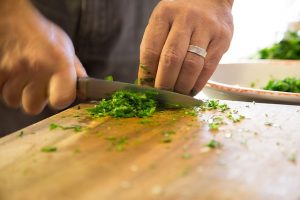For a person living with diabetes, learning to use healthier cooking techniques is an important step in developing healthy eating habits.
While making smart food choices is an essential element of diabetic meal planning and preparation, choosing smart cooking methods plays a huge role in defining what your finished product in the kitchen will be.
Even the healthiest foods can be turned into a nutritional nightmare based solely on the way you cook them.
The following methods are among the healthiest you can choose and are used throughout Diabetic Gourmet Magazine and The Diabetic Gourmet Cookbook [1]. By familiarizing yourself with these cooking techniques and practicing them by preparing our diabetic-friendly recipes, you may be able to modify the preparation of other recipes to your nutritional benefit.
Steaming:
One of the healthiest cooking techniques, steaming is cooking food over boiling water or other liquid. It requires no added oil or fat, it keeps food moist, and it retains most of the nutrients and flavor in the food. Recipe that uses this method: Asian-Style Steamed Salmon (below).
Grilling:
Grilling is cooking food directly over a heat source. Grilling is an especially good way to cook meat because it allows the fat to drip off. Recipe that uses this method: Grilled Citrus Chicken Skewers.
Broiling:
Broiling is similar to grilling, but the heat source is positioned above the food. Foods such as meat and poultry can be placed on a metal broiler pan that allows fat to drip away. Try it yourself with this Broiled Rainbow Trout recipe.
Pan-broiling:
Pan-broiling involves cooking meat, poultry, or fish in a heavy skillet over medium-high to high heat without any added fat, oil, or other liquids. Recipe that uses this method: Grill Pan Chicken With Fiery Mango-Ginger Salsa [3].
Baking and Roasting:
When you bake or roast food, you surround the food with dry heat, which cooks it. Baking and roasting are basically the same technique, although the term “baking” is typically reserved for breads, starches, pastries, fruits, and fish, while “roasting” is used more often for meats. Recipe that uses these methods: Baked Apple Pancake and Roasted Pork Loin with Apples and Cinnamon. Try baking this recipe for Miniature Apple Muffins [4] (below).
Sauteing and Stir-Frying:
Sauteing involves cooking food in a hot skillet with a small amount of fat, such as oil or butter. Stir-frying is basically the same thing, with a wok used instead of a skillet. Recipe that uses this method: Teriyaki Shrimp Stir-fry with Pineapple and Peppers [5].
Poaching:
Cooking food in water or some other liquid, such as stock or wine, at a temperature below boiling (between 160 degrees F and 180 degrees F) is called poaching. Poaching requires no added fat, and it is a great choice for cooking certain foods, especially delicate foods. Foods suitable for poaching include poultry, fruit, fish, and eggs. Recipe that uses this method: Lavender Poached Pears [6].
Simmering:
Simmering is very similar to poaching, but the temperature of the liquid is higher (between 185 degrees F and 205 degrees F). Simmering is useful for tougher cuts of meat that require a long, moist cooking environment and for liquids that need to be reduced. Recipe that uses this method: Beef Ragout.
Foil Cooking or En Papillote:
Foil cooking and cooking in paper (en papillote) require you to wrap food in aluminum foil or parchment paper so that it is sealed. The wrapped food is then heated in the oven, where it cooks in its own juices or a small amount of liquid that you may have added with the food. As the food cooks, the steam inside creates a moist environment that results in moist food. Try it yourself with this recipe for Halibut en Papillote with Roasted Tomato-Artichoke Ragout [8].
Braising and Stewing:
Cooking food for a long period of time in an amount of liquid, covered, is known as braising or stewing. Braising usually involves a large piece of meat that is browned in some fat before being combined with liquid and cooked either on the stovetop or in the oven. Stewing usually involves smaller pieces of food that are cooked or partially cooked before being combined with liquid and simmered. If a recipe asks you to brown meat in fat, we suggest coating your pot with non-stick cooking spray and just a small amount of canola oil. Try this chicken stew recipe [9]below.
